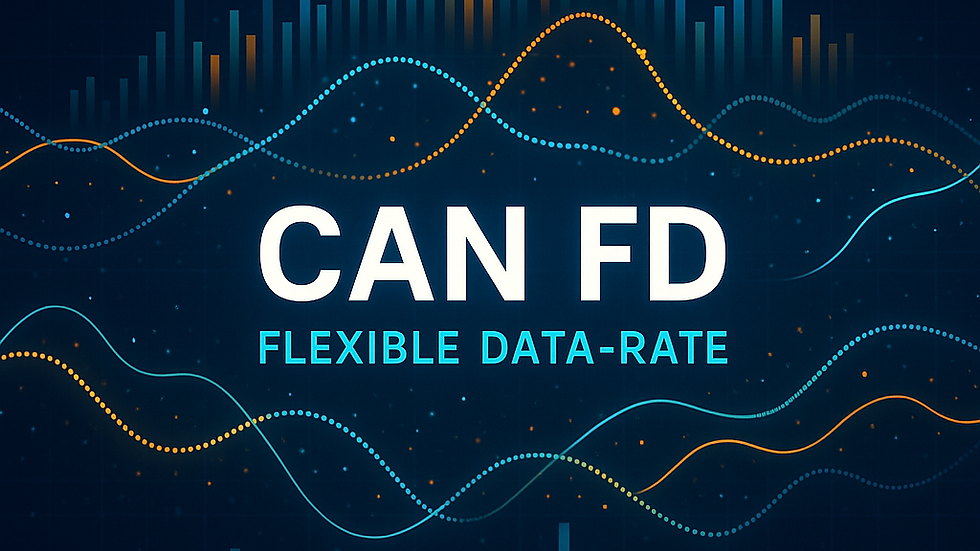Understanding CAN FD: The Future of Vehicle Communication
- Garrett Hiles

- Jun 27
- 3 min read
Updated: 5 days ago
CAN FD vs. CAN 2.0: What’s the Difference?
Traditional CAN 2.0 supports data rates of up to 1 Mbps and limits data frames to 8 bytes. While this worked well for decades, today’s vehicles demand much higher bandwidth and efficiency. That’s where CAN FD shines:
Higher Speeds: Data phase speeds reach 2–5 Mbps in practice (compared to the 1 Mbps arbitration-only rate for both).
Larger Data Frames: CAN FD supports data frames up to 64 bytes (while CAN 2.0 is limited to 8 bytes).
Reduced Protocol Overhead: This results in fewer fragmented messages and faster communication.
These improvements allow for more reliable communication, which is critical for Electric Vehicles (EVs), Advanced Driver Assistance Systems (ADAS), zonal architectures, and secure onboard systems.

Why It Matters: Security, Integrity & Efficiency
Beyond just higher data rates, CAN FD brings several architectural benefits:
Streamlined Protocols: Larger payloads simplify complex protocols like UDS and CANopen.
Enhanced Error Detection: Stronger CRC checks (17- or 21-bit vs. 15-bit in CAN 2.0) improve error detection.
Room for Secure Messaging: There’s capacity for secure messaging, including encrypted payloads and authentication tags.
Although the CAN FD spec does not inherently include encryption, many OEMs like GM layer encryption protocols on top of it. Platforms such as Global B implement hardware security modules (HSMs), seed-key access, and secure key storage on ECUs to enforce cybersecurity requirements.

What You Need to Implement CAN FD
Implementing CAN FD is more complex than typical software updates for small protocol shifts. You need a complete hardware and software stack to support it:
CAN FD-capable Transceiver: Essential for communication.
Microcontroller: Must support CAN FD protocols.
Updated Software Layer: This includes drivers and messaging logic.
The good news is that CAN FD controllers remain backward-compatible with CAN 2.0. This means you can create hybrid networks during the transition. It allows smoother upgrades across platforms while maintaining legacy tools and systems.
The Industry Is Already Adopting It
Around the world, most new OEM vehicle platforms now include CAN FD support, and many are adopting encryption. This has significant implications for various aspects of automotive technology:
Security: Reverse engineering becomes more challenging.
Aftermarket Tools: Many may soon require secure gateways and authentication for access.
Diagnostics: These increasingly rely on UDS and extended services over CAN FD.

What This Means for Our Clients
At SwitchBox, our focus is on teams developing thermal systems, embedded software, and next-generation vehicle architectures. Our solutions align with modern protocols, helping our clients with:
Evaluating CAN FD Readiness: Assess your current systems and prepare for transition.
Selecting Appropriate Microcontrollers and Transceivers: Ensure you have the right components.
Ensuring System Compatibility: Make sure your networks and diagnostics function smoothly, even with encryption.
If your platform involves ECU-to-ECU communication, diagnostics access, or embedded controls, it's critical to future-proof your design.
Let’s Build the Next Generation of Vehicle Systems
In today’s fast-paced automotive landscape, CAN FD isn’t just an upgrade — it’s the new standard. Whether developing advanced EV systems or retrofitting legacy platforms, SwitchBox is here to help you build secure, scalable, high-performance vehicle networks.
Final Thoughts
As we move forward, maintaining a competitive edge in automotive technology depends on your ability to adapt to communications advancements like CAN FD. Embracing these changes will ensure your systems meet the evolving demands of modern vehicles.
References
CSS Electronics. CAN Bus Explained – A Simple Intro
CSS Electronics. CAN FD Explained – Flexible Data-Rate Intro




Comments